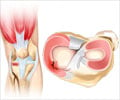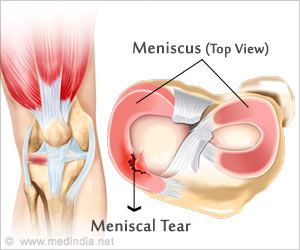Highlights
- Meniscal tear is the most common knee injury that occurs in anyone especially athletes.
- Most patients opt for removal of the entire meniscus which leads to health problems later in life.
- The new Living Bandage uses the patient’s own bone marrow cells to encourage cell growth and self-repair of the meniscal tear.
A meniscal tear is a common knee injury. The meniscus is a C-shaped cartilage found in the knee. There are two menisci in each knee joint.
A torn meniscus can occur in anyone. It is common among athletes, especially those who play contact sports.
In the young, a meniscal tear occurs suddenly during sports, when they squat and twist the knee or when they come in direct contact with a player.
While in older people meniscal tear happens gradually as a part of the aging process. Here, it is known as the degenerative meniscal tears as the cartilage wears out and thins with time, making it prone to tears.
Every year in the United States and Europe, more than 1 million people are affected by meniscal tears.
As a result most the professional athletes diagnosed with the injury opt to have their meniscus removed completely, exposing themselves to further health risks like osteoarthritis.
A Promising Way to Heal
The Cell Bandage could provide a better solution for this common problem. It is developed by the spin-off company Azellon. It is designed to encourage cell growth in the affected tissue thus enabling self-repair of the meniscal tear.
The procedure involves taking stem cells from patient’s bone marrow and growing them in the laboratory for 2 weeks. They cells are then placed on a membrane scaffold, which deliver the cells into the injured site.
The Call Bandage is inserted into the exact area of the tearing and the cartilage is sewn up to prevent movement of the bandage and encourage recovery.
Human Trial
For the trial of the Cell Bandage five patients between the ages 18-45 years were recruited.
One year post-implantation, all five patients reported full recovery. Two years later, 3 out of 5 patients still had no symptoms while 2 patients chose to have their meniscus removed due to a new tear or the return of the initial symptoms.
Professor Anthony Hollander, Chair of Stem Cell Biology at the University of Liverpool and Founder and Chief Scientific Officer of Azellon, said, "The Cell Bandage trial results are very encouraging and offer a potential alternative to surgical removal that will repair the damaged tissue and restore full knee function. We are currently developing an enhanced version of the Cell Bandage using donor stem cells, which will reduce the cost of the procedure and remove the need for two operations."
Since the results are promising, researchers want to further develop the new treatment to benefit a larger population.
The trial received funding support from Innovate UK and the promising results have been published in the journal Stem Cells Translational Medicine.
Reference
- Meniscal Tears - (https://www.medindia.net/patients/patientinfo/meniscal-tears.htm)
Source-Medindia










